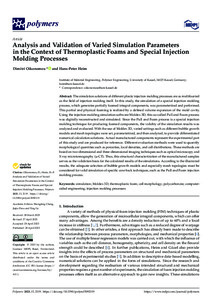| dc.date.accessioned | 2023-05-25T13:12:53Z | |
| dc.date.available | 2023-05-25T13:12:53Z | |
| dc.date.issued | 2023-04-28 | |
| dc.identifier | doi:10.17170/kobra-202305258109 | |
| dc.identifier.uri | http://hdl.handle.net/123456789/14760 | |
| dc.description.sponsorship | Gefördert durch den Publikationsfonds der Universität Kassel | |
| dc.language.iso | eng | |
| dc.rights | Namensnennung 4.0 International | * |
| dc.rights.uri | http://creativecommons.org/licenses/by/4.0/ | * |
| dc.subject | simulation | eng |
| dc.subject | Moldex 3D | eng |
| dc.subject | thermoplastic foam | eng |
| dc.subject | cell morphology | eng |
| dc.subject | polycarbonate | eng |
| dc.subject | computer-aided engineering | eng |
| dc.subject | injection molding processes | eng |
| dc.subject.ddc | 540 | |
| dc.title | Analysis and Validation of Varied Simulation Parameters in the Context of Thermoplastic Foams and Special Injection Molding Processes | eng |
| dc.type | Aufsatz | |
| dcterms.abstract | The simulation solutions of different plastic injection molding processes are as multifaceted as the field of injection molding itself. In this study, the simulation of a special injection molding process, which generates partially foamed integral components, was parameterized and performed. This partial and physical foaming is realized by a defined volume expansion of the mold cavity. Using the injection molding simulation software Moldex 3D, this so-called Pull and Foam process was digitally reconstructed and simulated. Since the Pull and Foam process is a special injection molding technique for producing foamed components, the validity of the simulation results was analyzed and evaluated. With the use of Moldex 3D, varied settings such as different bubble growth models and mesh topologies were set, parameterized, and then analyzed, to provide differentiated numerical calculation solutions. Actual manufactured components represent the experimental part of this study and are produced for reference. Different evaluation methods were used to quantify morphological quantities such as porosities, local densities, and cell distributions. These methods are based on two-dimensional and three-dimensional imaging techniques such as optical microscopy and X-ray microtomography (µ-CT). Thus, this structural characterization of the manufactured samples serves as the validation basis for the calculated results of the simulations. According to the illustrated results, the adequate selection of bubble growth models and especially mesh topologies must be considered for valid simulation of specific core-back techniques, such as the Pull and Foam injection molding process. | eng |
| dcterms.accessRights | open access | |
| dcterms.creator | Oikonomou, Dimitri | |
| dcterms.creator | Heim, Hans-Peter | |
| dc.relation.doi | doi:10.3390/polym15092119 | |
| dc.subject.swd | Simulation | ger |
| dc.subject.swd | Polycarbonate | ger |
| dc.subject.swd | Spritzgießen | ger |
| dc.type.version | publishedVersion | |
| dcterms.source.identifier | eissn:2073-4360 | |
| dcterms.source.issue | Issue 9 | |
| dcterms.source.journal | Polymers | eng |
| dcterms.source.volume | Volume 15 | |
| kup.iskup | false | |
| dcterms.source.articlenumber | 2119 | |


